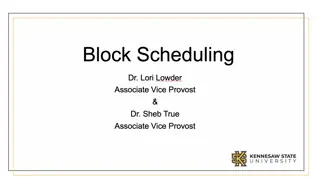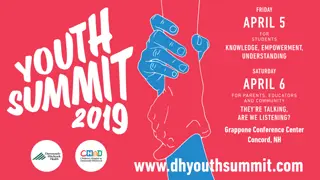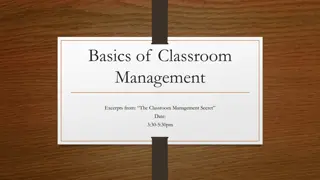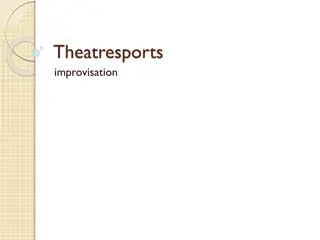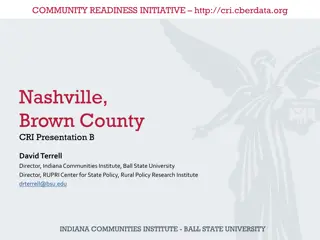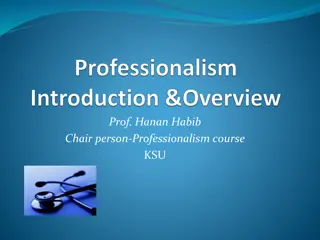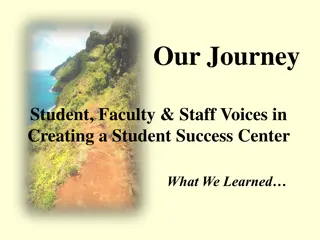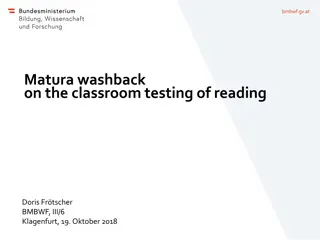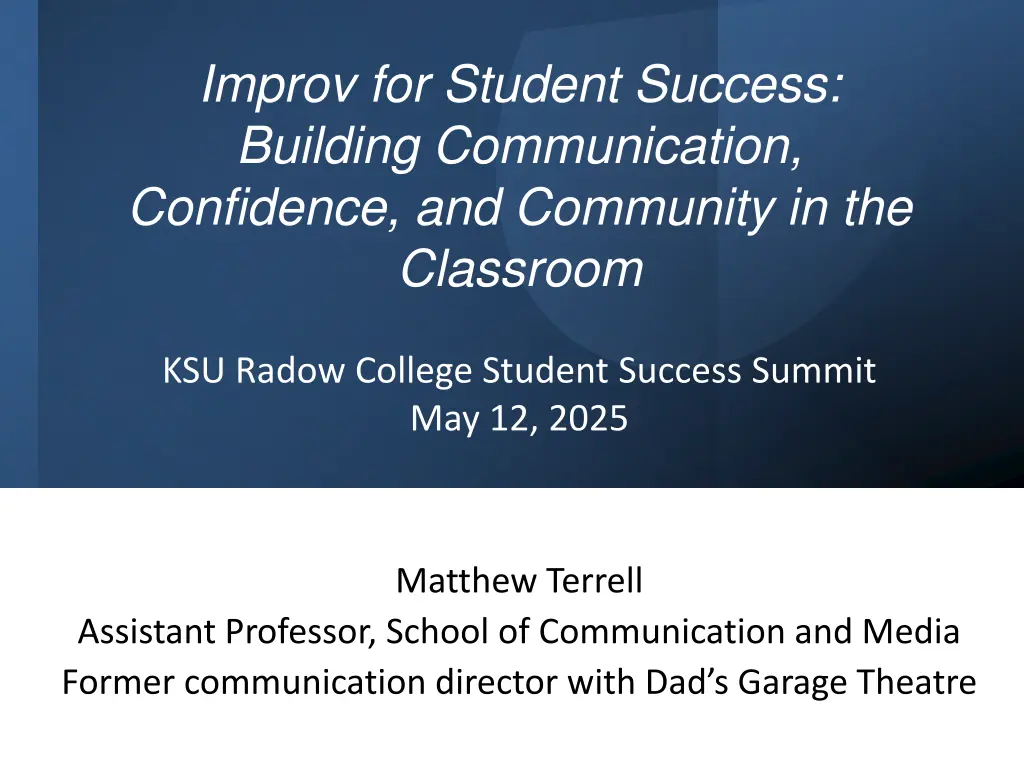
Empowering Students Through Improv for Communication and Community Building
Explore the benefits of using improvisation techniques in the classroom to enhance communication, creativity, and collaboration. Discover how improv fosters a safe space for students to take risks, build confidence, and engage in inclusive learning. From strengthening interpersonal skills to promoting positive thinking, improv transforms students into better communicators and empathetic individuals, ultimately shaping them into more outgoing and resilient members of the community.
Download Presentation

Please find below an Image/Link to download the presentation.
The content on the website is provided AS IS for your information and personal use only. It may not be sold, licensed, or shared on other websites without obtaining consent from the author. If you encounter any issues during the download, it is possible that the publisher has removed the file from their server.
You are allowed to download the files provided on this website for personal or commercial use, subject to the condition that they are used lawfully. All files are the property of their respective owners.
The content on the website is provided AS IS for your information and personal use only. It may not be sold, licensed, or shared on other websites without obtaining consent from the author.
E N D
Presentation Transcript
Improv for Student Success: Building Communication, Confidence, and Community in the Classroom KSU Radow College Student Success Summit May 12, 2025 Matthew Terrell Assistant Professor, School of Communication and Media Former communication director with Dad s Garage Theatre
Encourages spontaneous thinking and discussion Makes space for risk-taking and creativity in a safe environment Builds empathy, responsiveness, and trust among students Supports student-centered learning and inclusive participation Why Use Improv in the - Encourages spontaneous thinking and discussion - Makes space for risk-taking and creativity in a safe environment - Builds empathy, responsiveness, and trust among students - Supports student-centered learning and inclusive participation Humanities Classroom?
Immediate Benefits of Improv - Strengthens close listening and interpersonal communication - Helps students overcome fear of judgment in classroom discussions - Develops confidence in presenting ideas and responding in the moment - Builds intellectual flexibility key for writing, analysis, and discussion ENHANCES ENCOURAGES BUILDS COLLABORATION AND TEAMWORK COMMUNICATION SKILLS CREATIVITY
Long Term Impact of Improv Teaches students to be more outgoing and gregarious - Literature: interpretive discussion, character motivation, dialogue practice - History: cause and effect, perspective-taking, contingency in narratives - Philosophy: thought experiments, debate, questioning assumptions - Languages: vocabulary fluency, conversational flow, cultural responsiveness Reduces the fear of failure Encourages positive thinking and idea-building Makes them WANT to come to class Helps students become better human beings
What Improv Is NOT SKETCH COMEDY, OR ONLY A MEANS TO TELL JOKES. A SKILL THAT REQUIRES A THEATRE DEGREE TO TEACH. SOMETHING TO BE AFRAID OF. BORING!
Improv for Media & Communication MIMICS REAL- WORLD MEDIA PRODUCTION COLLABORATION ENHANCES STORYTELLING AND NARRATIVE DEVELOPMENT STRENGTHENS VERBAL AND IMPROV REFLECTS THE DYNAMIC, UNPREDICTABLE NATURE OF MEDIA WORK NON-VERBAL COMMUNICATION SKILLS
Todays Activities I ve chosen improv games that can be played individually, or in pairs. These are games that don t require instructors to moderate, and they allow students to let go and have fun. These are very broad activities that can fit into many different types of classes.
Round 1: Name the object youre pointing at Building Spontaneity: Wrong Name Game Round 2: Name the previous object you pointed at Round 3: Name anything but the object It s Simply Pointing and Naming things! Reduces overthinking and encourages fast, creative responses ONE RULE: You cannot point at another person.
Builds spontaneity and reduces fear of mistakes Encourages non-linear thinking, key in developing innovative ideas Takeaways from the Wrong Name Game Promotes quick responses and adaptability in communication Opens up the student s mind and gives them a door into their creative self.
Improving Listening Skills: First Word, Last Word Played in pairs as a normal conversation. Player A starts a conversation with a sentence. Player B responds, but the first word of their sentence has to the be the last word of Player A s Sentence. Player A responds back, using the last word of Player B s sentence as their first word. The game continues as long as you want.
A: What great weather we have today! B: Today is an incredible day to go swimming. A: Swimming is one of my favorite activities. B: Activities with my kids fill up my calendar. Example A: Calendar invites for play dates must keep you busy. B: Busy! That s putting it lightly!
Encourages listening to the entire message Takeaways from First Word, Last Word Game Slows down conversations, allowing for depth Builds connection between listening and responding, crucial for job interviews. Great exercise for anyone who speaks faster than they can think.
Building Cooperation: The 'Yes, and...' Game A classic improv game teaching collaboration, played in pairs. Player A makes an initial statement, Then B Responds, and A responds back Keep on going. Every responding sentence starts with "Yes, and... Each statement builds and escalates the scene Encourages accepting and expanding upon others' ideas
'Yes, and...' Game - Example A: "The river is full of fish. B: "Yes, and one of them is enormous. A: "Yes, and he's swimming toward us. B: "Yes, and he looks hungry. A: "Yes, and we are trapped in this boat. B: "Yes, and he looks more like a whale than a fish."
Takeaways from the 'Yes, and...' Game Teaches the value of accepting and building on ideas Encourages positive, cooperative interactions Highlights how accepting ideas fosters creativity Builds confidence and teamwork in professional settings
Everyone finds a partner for Rock Paper Scissors. The loser becomes the cheering section for the winner and walks around behind them chanting their name and applauding wildly as the winner goes on to challenge another winner. Every time a player wins, she adds the losing player (and their cheering section) to her cheering section. Rock Paper Scissors Thunderdome By the end there should be two surviving players going head to head with massive cheering sections behind each of them. When one of them becomes the ultimate champion, everyone cheers wildly and chants their name.
RPS Thunderdome Takeaways ISN T IT SO FUN TO HAVE SO MUCH SUPPORT FROM YOUR CLASSMATES? WHEN ELSE IN LIFE DO WE CHEER ON OUR CLASSMATES LIKE THIS? EXCELLENT FOR FOSTERING POSITIVITY IN CLASSROOMS WHERE THERE HAS BEEN TENSION OR NEGATIVITY. EVERYONE LOVES THIS GAME.
Players create a story one word at a time. Can be done in pairs or in groups. One player says the first word, the next says the second word etc. Collaborative Storytelling: Word at a Time Story At first you can start with Once, Upon, A, Time or One, Day.. and then move on top different starting sentences. Encourage students to have a character, a location, and something at stake. (Basic elements of storytelling)
Example A: Once B: Upon A: A B: Time A: There B: Was A: A B: Hermit A: Who B: Lived B: A: In B: A A: Cave A: He Because A: B: Was A: Scared B: Of Everyone
Takeaways from Word at a Time Story Teaches collaboration and building on others ideas Highlights the balance between structure and spontaneity Helps participants let go of control, essential for teamwork Things happen, People Change If players get stuck in a loop that goes nowhere (and the dog ate a treat, then the dog took a nap, then the dog went for a walk), it shows that them that Occurrence Action. Action=The dog ate a treat, and liked it so much it begged for more. Then the owner realized the dog liked these treats, so he bought more of them
Why Professors Should Use Improv Enhances student engagement in discussions and classroom life. Strengthens problem-solving and confidence Helps students step outside comfort zones, preparing for real-world professional scenarios
Key Takeaways for Professors Active Listening: Critical for group projects Spontaneity: Key for creative problem solving Collaboration: Reflects the teamwork needed in professional environments Creativity: Encourages out-of-the-box thinking for storytelling and innovation
Final Thoughts on Improv in the Classroom Fosters better communication, creativity, and collaboration Improv builds essential skills for all students Encourages students to engage more confidently and openly Try one improv activity in your next class!
Questions & Discussion
Matthew Terrell Thank You! mterre20@Kennesaw.edu Thank you for your time!

